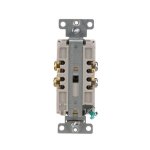Residential I see mostly wiring to device.
Commercial: I've been seeing more of this: https://www.leviton.com/en/docs/Lev-Lok_Brochure_Q-360T.pdf
Commercial: I've been seeing more of this: https://www.leviton.com/en/docs/Lev-Lok_Brochure_Q-360T.pdf

